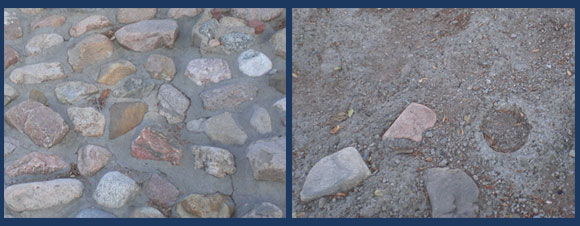( Originally posted to my “From Here to Discernity” blog at SantaFe.com, November 21, 2011)

I live within walking distance of DeVargas Center on the north side of town. Two or three times a week I’ll walk by the mall, or to the mall, depending on my needs or curiosities.
Yesterday my curiosities led me to notice the rocked slopes that separate the high ground of the Wells Fargo Bank at the corner of Paseo de Peralta and Guadalupe, from the lower parking lot in front of Sunflower Farmers Market and Mattress Firm.
I’ve often walked down the stones on the slope as a shortcut from Paseo de Peralta to the mall. The stones are set in a base of cement, presumably to hold the stones in place as well as to prevent erosion of the soil on the slope. (Although I’m not sure that suffocating the soil with cement was done for the benefit of the underlying soil as much as to keep it out of the asphalt parking lot below.)
In a couple of places, enough stones are missing that it’s easier to walk up and down the embankment. I was walking down one of these “paths” yesterday when I was struck with the realization that these missing stones mean something. At least, they meant something to me.

The layer of cement serves as a foundation for the stones. The foundation was intended to hold the stones in place while providing a decorative and functional “natural-looking” covering for the slope. But over time, some of the stones had broken free of the foundation and rolled away, or were carried away. The foundation remains, but some of the stones that were set into the foundation are no more.
What kind of homily would you take from this? What lessons, associations, or metaphors could be drawn from this picture of stones broken free from their foundation?
What I drew from it, even as I was blithely stepping where the stones had been, was that this was about the failure of the foundation. The cement foundation was supposed to hold the stones in place. Some of the stones were gone, so the foundation failed its purpose, even though the foundation itself was still intact. And while it still covered the terrain, it didn’t hold the stones that were set into it.
I think that’s a good metaphor for what we humans have learned to do with all manner of beliefs.
Like the cement foundation on the slope, we lay down a certain set of fixed beliefs about how things should be. We have religious beliefs, of course, but also political, cultural, romantic, artistic, academic … in virtually every domain of experience, we maintain a foundation of beliefs about the way things are, and the way things ought to be.
As we go through our lives, we accumulate experiences that we set into our base of beliefs, like the stones set into the cement. Our beliefs bind our actions and life experiences into a rock-solid understanding of what our life events mean. Our beliefs hold our doubts and insecurities and uncertainties in check; they prevent our “soul erosion,” just as the cement on the slope prevents soil erosion.
But the problem is, sometimes we have life experiences that become unbound from our belief systems. We have a Penn State child rape scandal. We have police pepper-spraying college students on campus. In the midst of economic crisis, we have unapologetic politicians bound to ideology more than attacking the crisis. We have some who value corporate interests over human interests, for whom “excess” represents a strategic objective rather than a constraint.
These are just a few of many distressing real-world examples in which our institutional beliefs ought to be shattered. Time after time, misplaced faith in someone or some institution results in tragedy, or scandal, or misfortune.
And yet, like the cement on the slope at the DeVargas Center, our beliefs remain intact, undeterred by any awareness that they have failed us.
We accommodate the unbounded experience as an outlier, an exception. We rest comfortable with the lazy rationalization that, while our beliefs didn’t bind this particular tragedy or mishap, look at all the other stones on the slope that are still fixed firmly in the foundation!
The important thing is the constancy of our beliefs. The important thing is the uncritical and undoubtable loyalty to the Party, the University, the Authority, the Status Quo, the Tradition.
It’s all about the cement and the stones that stay in place. It’s not about the stones for which the foundation fails, that unbind and roll away.
Until, that is, the next time our blind obedience to a broken belief yields the inevitable next manifestation of “the unthinkable.” Then it will be about those other stones.
Until the next news cycle. But it will never be about the failure of the foundation and broken beliefs.
